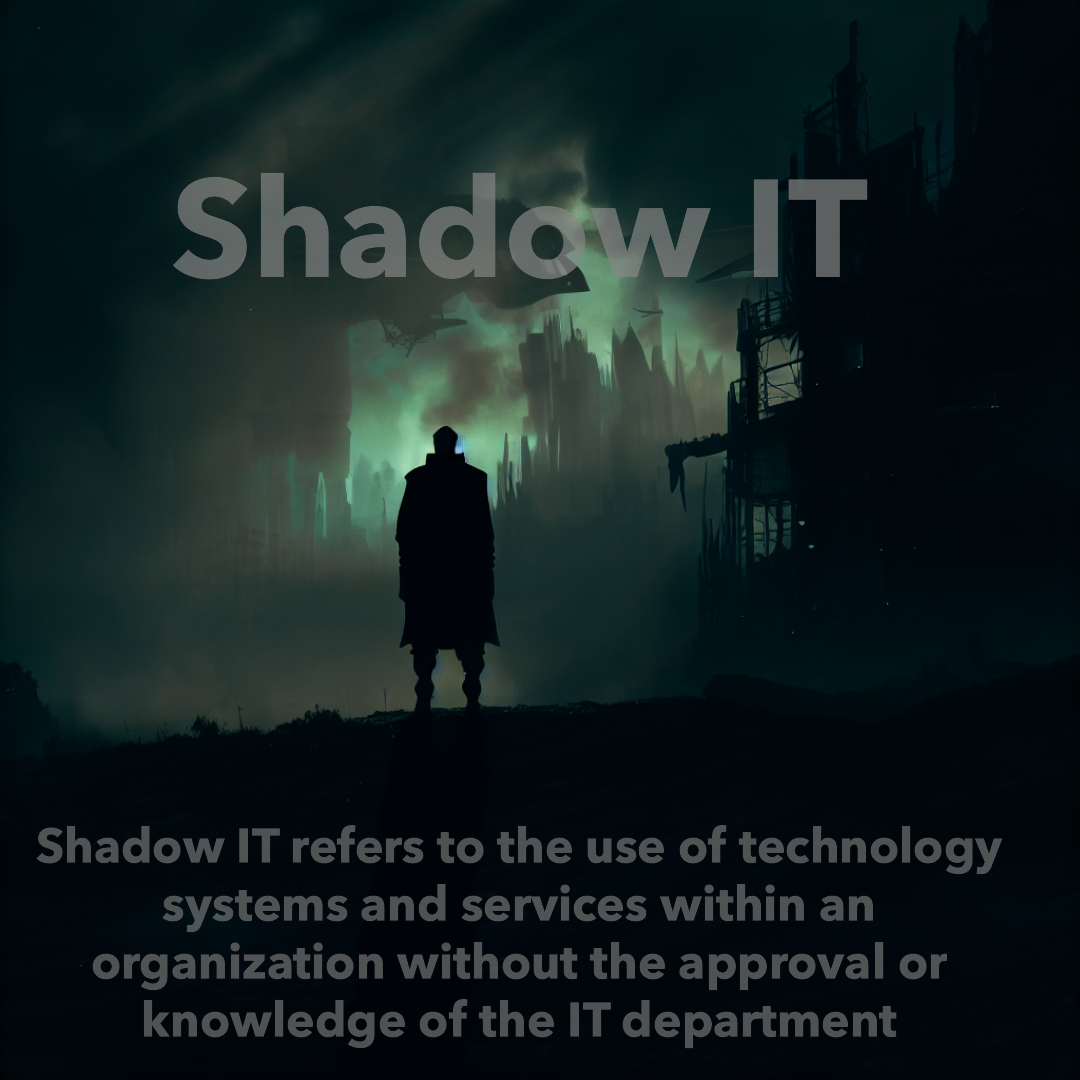Shadow IT
Shadow IT refers to information technology (IT) systems deployed by departments other than the central IT department.
What is Shadow IT?
Shadow IT refers to the use of technology systems and services within an organization without the approval or knowledge of the IT department. This can include hardware, software, or cloud services that are not officially sanctioned by the organization's IT policies and procedures.Shadow IT can occur when employees use personal devices or technology solutions to conduct work-related tasks, or when departments within the organization purchase and use technology solutions without going through the proper channels for approval and integration with existing systems.
Shadow IT can introduce a range of risks to an organization, including security vulnerabilities, compliance issues, integration challenges, and productivity inefficiencies. It is important for organizations to manage Shadow IT proactively by implementing policies and procedures to detect, monitor, and control the use of unapproved technology solutions.
Examples of Shadow IT can include the use of personal laptops or mobile devices for work-related tasks, the use of unapproved software or cloud services to store or share data, and the purchase of technology solutions by departments without approval from the IT department.
Shadow IT can occur for a variety of reasons, including a lack of understanding of the risks associated with using unapproved technology solutions, a desire for more flexibility or control over technology resources, or a lack of confidence in the IT department's ability to provide adequate technology solutions.
Risks associated with Shadow IT can include security vulnerabilities, compliance issues, integration challenges, productivity inefficiencies, and financial risks.
Organizations can manage Shadow IT by implementing policies and procedures to detect, monitor, and control the use of unapproved technology solutions. This can include regular audits of technology assets, the creation of an IT governance framework, and the use of technology solutions that provide visibility and control over the use of technology resources.
Organizations can educate employees about the risks of Shadow IT through training programs, communication campaigns, and the provision of clear policies and guidelines for the use of technology resources. It is important to emphasize the potential risks to both the organization and the individual employee, and to provide guidance on how to report potential Shadow IT incidents.
Shadow IT Risks
| Security risks | When employees use unapproved technology solutions, it can create security vulnerabilities, such as the introduction of malware, data breaches, or unauthorized access to sensitive data. |
|---|---|
| Compliance risks | Shadow IT can result in non-compliance with legal and regulatory requirements, such as data privacy laws, financial regulations, or industry-specific standards. |
| Integration risks | Unapproved technology solutions may not integrate effectively with existing systems, leading to inefficiencies, errors, and duplication of efforts. |
| Data loss risks | Unapproved technology solutions may not have the same data backup and recovery mechanisms as authorized systems, which can result in data loss or corruption. |
| Productivity risks | Shadow IT can create inefficiencies and reduce productivity when employees use non-standard solutions that are not integrated with other systems or do not have the same features and functionality as authorized solutions. |
| Financial risks | Shadow IT can lead to unnecessary expenses, such as the purchase of redundant technology solutions or the cost of maintaining unapproved systems. |
| Reputation risks | Security breaches or compliance violations resulting from Shadow IT can damage an organization's reputation and erode trust with customers and stakeholders. |
| Loss of control | Shadow IT can result in the IT department losing control over technology assets, including access to data, software, and hardware. |
| Lack of support | When employees use unapproved technology solutions, they may not receive the necessary support or maintenance, leading to downtime or disruptions. |
| Inconsistent standards | Shadow IT can lead to inconsistent technology standards across the organization, making it difficult to manage and support technology assets. |
| Lack of visibility | Without proper monitoring and reporting, IT departments may not have visibility into the use of unapproved technology solutions, leading to blind spots and potential security gaps. |
| Vendor lock-in | Shadow IT can result in the organization becoming locked into specific vendors or technologies, limiting future flexibility and adaptability. |
| Reduced innovation | When employees use unapproved technology solutions, they may be less likely to explore and adopt new technologies that could benefit the organization. |
| Duplication of efforts | Shadow IT can result in duplicate efforts, with employees using different technology solutions to accomplish the same tasks. |
| Operational risks | Unapproved technology solutions may not have the same level of reliability or scalability as authorized systems, leading to operational risks and downtime. |
| Lack of training | Employees may not receive the necessary training or education on how to use unapproved technology solutions, leading to inefficiencies and errors. |
| Regulatory risks | The use of unapproved technology solutions can result in non-compliance with industry-specific regulations and standards, leading to potential legal and financial risks. |
- Snippet from Wikipedia: Shadow IT
In organizations, shadow IT refers to information technology (IT) systems deployed by departments other than the central IT department, to bypass limitations and restrictions that have been imposed by central information systems. While it can promote innovation and productivity, shadow IT introduces security risks and compliance concerns, especially when such systems are not aligned with corporate governance.
